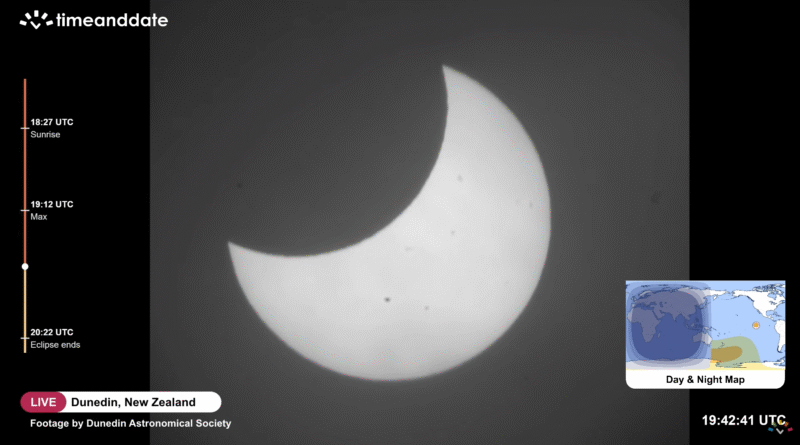Top Highlights
-
On September 21, a spectacular partial solar eclipse transformed the sun into a radiant crescent over the Pacific, marking a significant celestial event.
-
The eclipse, occurring during the new moon phase, allowed the moon to partially obscure the sun, creating a striking visual display captured by observers in New Zealand.
-
At maximum eclipse, 70% of the sun was covered by the moon, causing interesting crescent-shaped light patterns visible through small openings like colanders.
-
The next solar spectacle will be an annular eclipse on February 17, 2026, visible from southern Africa and Antarctica, prompting enthusiasts to prepare with eclipse glasses and photography tips.
Moon “Bites” the Sun in Stunning Partial Solar Eclipse Photos
On Sept. 21, a partial solar eclipse captivated observers across the Pacific Ocean. This celestial event transformed the sun into a brilliant crescent, showcasing the beauty of our solar system’s mechanics.
During the monthly new moon phase, the moon moves between Earth and the sun. Thus, it partially obscures the sun’s light, creating an awe-inspiring spectacle. Images from the event reveal the moon’s silhouette gliding across the sun’s fiery face.
Many watched as the eclipse deepened. The Dunedin Astronomical Society captured stunning visuals just after sunrise. From Dunedin, New Zealand, spectators saw the sun peek through a thick cloud bank, only to be “bitten” by the moon moments later.
As the eclipse reached its maximum, about 70% of the sun’s surface vanished. This dramatic shift in light created crescent shapes in shadows cast by small openings, like colanders. Moreover, the day illuminated the importance of promoting scientific curiosity and education.
After the peak, the moon slowly retreated, revealing the sun’s brilliance once more. Each part of this celestial dance reminded viewers of our connection to the universe.
The excitement does not end here. Stargazers can look forward to an annular solar eclipse on Feb. 17, 2026, visible from southern Africa and Antarctica. Meanwhile, enthusiasts can prepare by obtaining proper eclipse glasses and learning safe photography techniques.
These events inspire technological advancements in astronomy, enhancing our ability to observe and understand the cosmos. As science progresses, so does our appreciation for the universe’s wonders, enriching everyday life and expanding knowledge. The beauty of these celestial displays invites everyone to take a moment and gaze upward.
Continue Your Tech Journey
Learn how the Internet of Things (IoT) is transforming everyday life.
Explore past and present digital transformations on the Internet Archive.
SciV1

